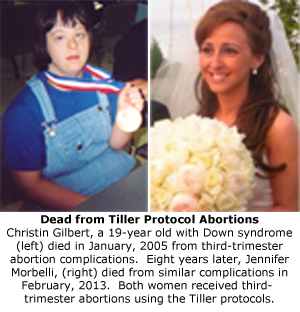
FACTS ABOUT LATE-TERM ABORTIONS IN THE U.S.
A survey of all abortion facilities in the US. is conducted annually by Operation Rescue. This survey data represent the most up-to-date and accurate available.
We define “late-term abortion” as any abortion done at 14 weeks gestation or later. That is when the babies have grown large enough that the first trimester abortion procedures and abortion-inducing drugs can no longer be used.
The most recent survey, which took place in November-December 2020, found the following developments related to gestational ages when abortions are currently being done at abortion facilities in the U.S. [Read the full two-part report: Part 1; Part 2.]
- The percentage of surgical abortion facilities that self-impose abortion limits at 13 weeks or under dramatically dropped over the past two years from 46% in 2018 to just 19% in 2020. The category of abortion facilities that place gestational limits at 14-19 weeks grew the fastest in 2020, now comprising 51% of all abortion facilities.
- The number of abortion facilities willing to do abortions at 20 weeks gestation or later dropped slightly by one percent in 2020. Thirty percent of all abortion facilities now conduct abortions that late into pregnancies.
The following chart note the percentage of surgical abortion facilities that conduct abortions at various gestational ages. It is easy to see that 81% of all surgical abortion facilities conduct late-term abortions in the second and/or third trimesters of pregnancy.
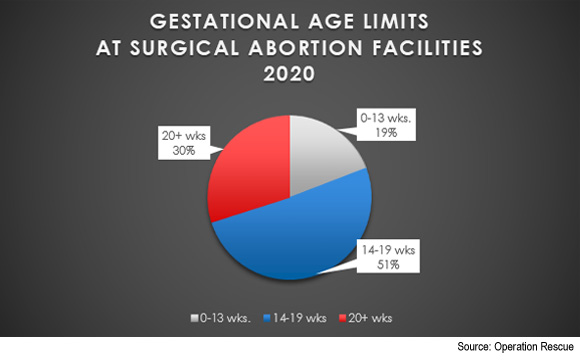
While most states set gestational limits for abortions, each abortion facility has its own self-imposed limit on how far into a pregnancy they are willing to conduct an abortion. The graph below reflects those self-imposed limits and give a more accurate picture of how American abortion facilities are actually functioning.
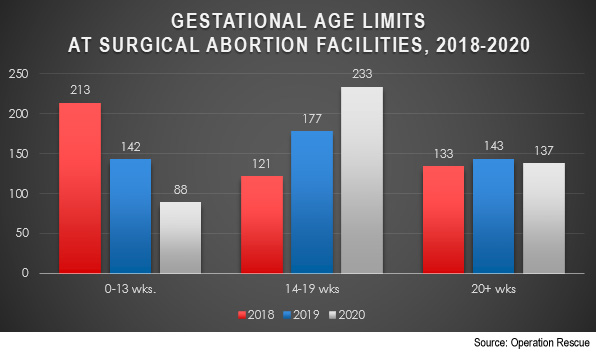
The states where the 137 abortion facilities that conduct abortions at 20 weeks gestation or later are shown in the map below.
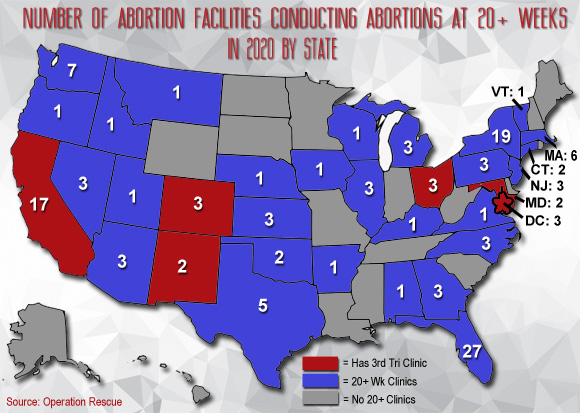
Independent abortion businesses still account for the vast majority of facilities willing to abort at 20 weeks or later. Of the 137 facilities that conduct the later abortions, 106 are independently operated facilities, while 31 are affiliated with Planned Parenthood.
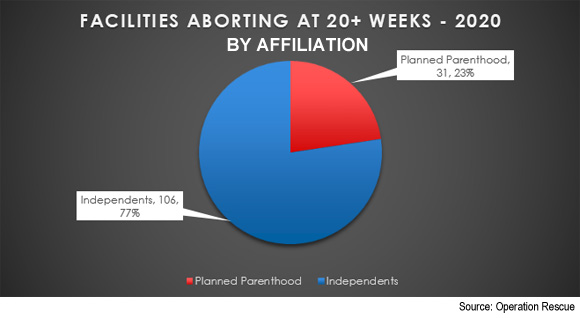
Abortion facilities that offer abortions throughout all stages of pregnancy are open about having no gestational limits. Others may state limits under the third trimester of pregnancy even though they actually will conduct them much later. Abortion facilities with “fetal indications” programs or conduct abortions for other so-called “medical” reasons, have essentially stripped away all stated gestational limits.
Seven abortion facilities openly abort throughout all nine months. Those include:
- Boulder Abortion Clinic in Boulder, Colorado.
- Stated limit: 30 weeks. (No longer does first trimester abortions.) Owner: Warren Hern.
- Capital Women’s Services in Washington, D.C.
- Stated limit: 36 weeks. Stake Holder: Steven Chase Brigham.
- CARE (Formerly AbortionClinics.org) in Bethesda, Maryland.
- Stated limit: 35 weeks. Owner: LeRoy Carhart.
- Southwestern Women’s Options in Albuquerque, New Mexico.
- Stated limit: 32 weeks. Owner: Curtis Boyd.
- Washington Surgi-Clinic
- Stated limit: 27 weeks. Owner: Cesare Santangelo.
- Women’s Med Center in Dayton, Ohio.
- Stated limit: Under 22 weeks. Owner: Martin Haskell.
- DuPont Clinic, Washington, D.C.
- Stated limit: Under 32 weeks. Operators: Matthew Reaves, Stacey Rubin, and Jessica Kuperstock.
It is more than likely that other abortionists also conduct third trimesters but are less open about it.
Most Americans Oppose Late-term Abortions
On June 21, 2021, the results of an AP-NORAC poll were released. This poll noted that for pregnancies in the second trimester, 65% of Americans said that abortion should be illegal in most or all cases.
Opposition to abortion in the third trimester of pregnancy was even stronger. A full 80% of respondents said abortions in the seventh, eighth, and ninth months of pregnancy should be illegal in most or all cases.

THE PROCESS: INDUCTION ABORTION
Also known as the “MOLD Technique”
The induction abortion with the use of digoxin injection was pioneered by late-term abortionist George R. Tiller of Wichita, Kansas, and is now widely used throughout the United States by the few abortionists who are willing to admit they do the late-term procedures. It has replaced the live partial birth abortion method since the Partial Birth Abortion Ban act was upheld by the U.S. Supreme Court in April, 2007.
In videos obtained by Operation Rescue, Tiller is seen describing this particular abortion method, known as the MOLD Technique, which is an acronym for the four products employed in the abortion process: Misoprostol, Oxytocin, Laminaria, and Digoxin.
Currently, this late-term abortion process is in use in pregnancies as late as 35 weeks. It is used when the baby grows too large to make dismemberment (Dilation and Evacuation or D&E) abortions impractical due to the calcification of bones and development of ligaments and musculature in the growing baby’s body.
“We think the process is safe. Nothing is perfect.” – George Tiller
The Induction abortion takes 3-4 days to complete. On the first day the woman is given an ultrasound to determine the gestational age of her baby. Then, with the aid of the ultrasound to guide the abortionist, a lethal dose of the heart medication Digoxin is injected into the baby’s heart or into the amniotic fluid directly through the woman’s abdomen. (Potassium chloride is infrequently substituted for Digoxin.) Digoxin gives the baby a fatal heart attack. This is an off-label application of the drug, which was originally developed and approved as a treatment for heart disease. In some cases, the injection can be made vaginally instead of through the abdomen.
In a video shown to abortion patients, Tiller discussed the fatal injection:
“Although you may find this a little difficult and a little uncomfortable, on the first day that you arrive at the clinic we will make an injection of a medication called digoxin into the fetus to initiate fetal demise.”
Tiller elaborates on his reasons for killing the baby before beginning the surgical abortion procedure.
“The first reason is so that there will be no fetal pain. We — we have learned with hundreds and hundreds and hundreds of patients that women have the question about, ‘Will this be painful for our baby? Will this be painful for my baby?’ And the answer to that is ‘no.’ We make an injection directly into the fetus with a medication called digoxin on the day that you arrive so that the baby will expire painlessly. The first reason is no fetal pain.”
However, those who have experienced massive heart attacks, describe them as extremely painful and frightening. It is well documented that babies in the later stages of pregnancy can feel pain, and at least one study indicates that babies as young as 6-8 weeks gestation may experience pain.
While the concept that a late-term baby can feel pain is often disputed in the press and by abortion supporters, it is obvious that Tiller believed that late second and third trimester pre-born babies can feel pain, and thus used his lethal fetal injection as a means of allaying the concerns of abortion patients.
But the most important reason for killing the baby first is to avoid a live birth. This prevents myriad of problems for the abortionists, including running afoul of state and federal laws protecting the life of the baby after a live birth, even if the birth is the result of an abortion.
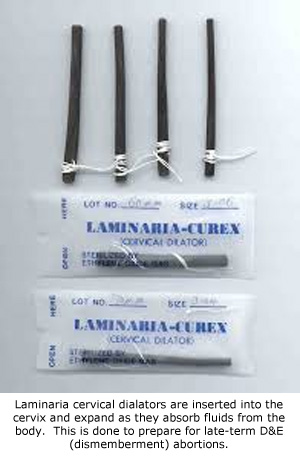
After the Digoxin injection, the woman’s cervix is packed with laminaria, thin tampon-like sticks made of seaweed that expand the cervix gradually over the next day. The drug Misoprostol is also administered vaginally to “ripen” the cervix for the upcoming delivery of the dead baby.
Misoprostol is a drug that was originally manufactured to treat stomach ulcers. Its use in abortions is an off-label application not approved by the FDA. Misoprostol stimulates uterine contractions which are unpredictable and sometimes violent.
After the first day’s injection and cervical preparation, the patient is sent home or to a local hotel where she will remain unmonitored until her appointment at the clinic the following day.
On Day 2 of the procedure, the woman is repacked with larger laminaria sticks and given additional Misoprostol to prepare the woman for labor. The Misoprostol may be administered both vaginally or bucally (between the cheek and jaw), depending on whether delivery is expected on Day 3 or 4. If the woman is undergoing a later, 4 day process, she will return on Day 3 for additional laminaria and Misoprostol. Each day until delivery, she is sent back to her hotel where she remains unmonitored, even though active labor had begun or was in progress.
Sometimes, women cannot be able to get to the clinic in time and deliver their dead babies in the hotel, in vehicles, or other places were medical assistance is nonexistent. Tiller admitted so much in an video he produced for the purpose of introducing prospective abortion patients to the late-term abortion process.
“At Women’s Health Care Services, our late elective abortion program involves managing the pregnancy by the premature delivery of a stillborn.” – George Tiller
On the final day of the abortion, the woman is given the drug Oxytocin, which induces or augments contractions and the onset of labor. Women then are placed in a room where they endure the final stage of labor process. When it is determined that the labor has progressed to the point where the baby is about to be delivered, each woman is usually taken into a room with a toilet and told to lean on the nurse and push the baby into the toilet.
The toilet delivery method is used by a number of abortionists, including Florida abortionist James Pendergraft. Other abortionists may allow the woman to deliver on a delivery table. Still others, such as former Michigan abortionist Alberto Hodari, prefer to remove the dead baby through dismemberment.
Once the dead baby is delivered, the woman is given a procedure called Dilation and Curettage, or D&C. Here, a sharp edged spoon-shaped instrument is used to remove the remaining tissue, such as the afterbirth, from the uterus.
After the abortion, or the following day, the woman is given what Tiller’s employees called the “Party Pack,” which includes abortion aftercare instructions and a prescription for birth control pills. They are then released to return home.
Other abortionists have responded publicly to the increased use in the Induction abortion with digoxin injection method and its dangers.
The now retired Michigan abortionist Alberto Hodari preferred to dismember live babies between 18 and 24 weeks. He told the Detroit News on July 30, 2007, “It was much simpler and much less dangerous than what we are doing now. But this is now the law. It’s awful. It’s unnecessary. It’s dangerous. It’s more complicated. It makes the woman go through another procedure that’s not necessary. It impacts everything we do after 18 weeks.” Hodari began using the injections even though he considers them dangerous.
“We do not believe that our patients should take a risk for which the only clear benefit is a legal one to the physician,” abortionist Philip D. Darney, Director Emeritus at the Bixby Center for Global Reproductive Health, which pushes a depopulation agenda around the world, told the Boston Globe on August 10, 2007. He has chosen not to use the injections.
Complications from lethal fetal injections are well known. In Orlando, Florida, the misuse of Digoxin resulted in the live birth of Baby Rowan, who died after abortion clinic workers denied him medical care. In Wichita, Kansas, Tiller’s needle slipped, and Baby Sarah was injected in the head with a toxic drug that was a precursor to digoxin. She survived and was later adopted, but suffered a malady of medical problems. She died five years later from complications to the injuries she received as a result of the injection.
“But frankly, debate over digoxin/dead baby abortions versus live baby abortions is absurd. The result is still a dead baby. Both procedures are barbaric and hold serious risks to women,” said Operation Rescue Senior Police Advisor Cheryl Sullenger. “The act of killing a pre-born baby is in itself immoral and until we can come to grips with that as a society, we never be able to value life as we should.”
RISKS INCREASE WITH LATE-TERM ABORTIONS
Women also run additional risks when submitting to this abortion procedure. For every week that passes, abortion risks to women’s health and life increase.
One woman suffered a ruptured uterus during a 35-week abortion done by Shelley Sella in Albuquerque, who ignored the patient’s medical history of a previous Cesarean Section delivery for which the use of Misoprostol is contraindicated. Sella was charged by the New Mexico Medical Board for gross negligence in this case, but escaped punishment.
Christin Gilbert, 19, and Jennifer Morbelli, 29, died from complications to third-trimester abortions done by LeRoy Carhart. Both women suffered a complication known as disseminated intravascular coagulation (DIC), a blood clotting disorder that leads to massive hemorrhage. Gilbert may also have suffered from sepsis, a live-threatening blood infection. Morbelli’s complications included an amniotic embolism, which is a treatable condition if caught in time.
There is rising concern that the entire Induction process as practiced by Sella, Carhart, and others, is too dangerous for use in outpatient clinics since women who have begun the surgical abortion process are left unmonitored outside the clinic for long periods of time without access to immediate emergency care.
Dr. Gerald L. Bullock, a Texas Obstetrician and Gynecologist considered an expert in the field, has expressed his professional opinion that the process violates the standards of patient care because if fails to follow the accepted protocols set forth by the American Congress of Obstetricians and Gynecologists.
Hospital whistleblower describes horrific injuries to 25-week botched abortions
In 2020, a whistle-blower from a local hospital came forward to describe two the gruesome to two women who received late-term abortions at LeRoy Carhart’s C.A.R.E. clinic in Bethesda, Maryland — one on May 12, 2020, and the other on May 21, 2020. Both women, who were 25 weeks pregnant, suffered from large holes that were torn in their wombs during the abortions. Both were hospitalized for several days, underwent emergency surgery, and received multiple units of blood to save their lives. [Read the full report substantiating documents.]
According to the whistleblower, those involved in treating the woman involved in the May 12 medical emergency were so upset by what they saw that the surgeon witnessed the need to send out an e-mail to the hospital staff acknowledging their trauma while caring for this woman.
This hospital worker described the injuries to the second woman who was hospitalized on May 21, 2020, as “the most horrific thing I have ever seen.”
Don’t let this happen to you.
Related resources:
New Mexico Medical Board Disciplinary Hearing Transcripts in the case of Shelley Sella, November 29-30, 2012:


